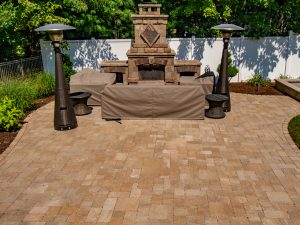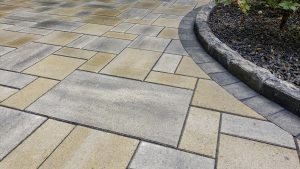
Stamped Concrete vs. Pavers: Which Is Better?
Stamped concrete or pavers are great alternatives when you want something a little more interesting than poured concrete for your hardscaping. Both options provide similar looks, but they each have different pros and cons that property owners need to consider carefully when making decisions for their hardscape. The expert designers at Triad Associates have installed both pavers and stamped concrete, and they can help you explore the options to determine which would be right to achieve your vision and goals.
Here’s what you would need to consider when choosing between stamped concrete or pavers.
Stamped Concrete and Paver Design Options
 Similar designs can be achieved with both stamped concrete and pavers. Concrete can be stamped to match the design of pavers or other patterns. Any design that can be put on a stamp can be used with concrete, whereas pavers are limited to the shape they’re cut to. Stamped concrete can also be dyed to help emphasize the design. Pavers are pre-dyed and therefore cannot be customized to a particular color.
Similar designs can be achieved with both stamped concrete and pavers. Concrete can be stamped to match the design of pavers or other patterns. Any design that can be put on a stamp can be used with concrete, whereas pavers are limited to the shape they’re cut to. Stamped concrete can also be dyed to help emphasize the design. Pavers are pre-dyed and therefore cannot be customized to a particular color.
Maintaining Stamped Concrete and Pavers
Maintenance is relatively easy for both stamped concrete and pavers. Though, maintaining stamped concrete is a bit easier. Occasionally sweeping and scrubbing stamped concrete will keep it looking great. However, concrete needs to be sealed periodically to maintain the integrity and longevity. With pavers, you will have to work to keep the weeds out of the cracks, and you will need to replenish the joint sand periodically.
Stamped Concrete Durability vs. Pavers Durability
 Pavers have the advantage for durability. They can shift with the changes in the temperature or weather without cracking or breaking. On the other hand, stamped concrete is more prone to surface cracks with seasonal changes. If a paver ever becomes damaged, it can be easily removed and replaced. Stamped concrete requires more intensive intervention to repair properly.
Pavers have the advantage for durability. They can shift with the changes in the temperature or weather without cracking or breaking. On the other hand, stamped concrete is more prone to surface cracks with seasonal changes. If a paver ever becomes damaged, it can be easily removed and replaced. Stamped concrete requires more intensive intervention to repair properly.
Despite these differences, both materials have a similar lifespan: About 30 years or more when properly maintained.



